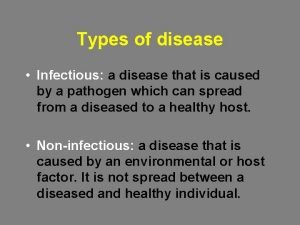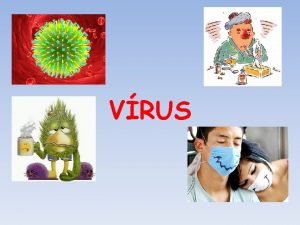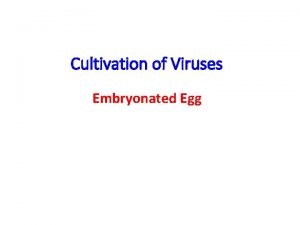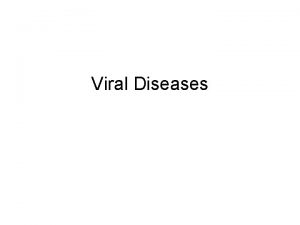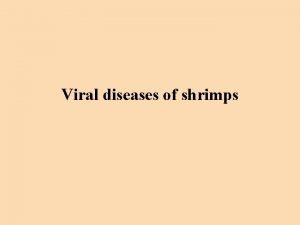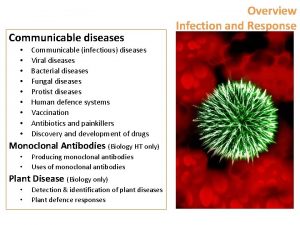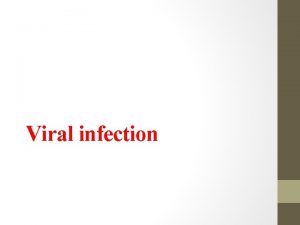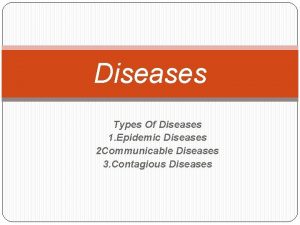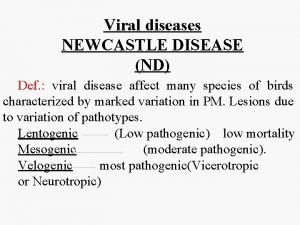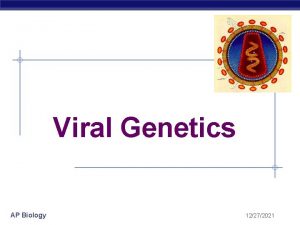Viral Diseases Viral types and Diseases Group and










- Slides: 10

Viral Diseases

Viral types and Diseases Group and type of virus Description of disease 1. Double-stranded DNA Viruses Papilloma virus (Small virus Warts, which are rough, that causes tumors) elevated benign tumors on the skin, urinary tract, or genitals Herpes virus (Medium to large size enveloped virus) Herpes simples virus (human herpes virus – HHV) Fever blisters, which are painful or itchy recurrent vesicular lesions usually on the lips or genitals; Poxvirus (Very large, Replication of the virus causes enveloped, brick-shaped virus) smallpox, a deadly disease that has been eliminated

Group and type of virus Description of disease 2. Single-stranded (Plus-strand) RNA Viruses Picornavirus Poliomyelitis (commonly called polio or infantile paralysis) meningitis Rhinovirus Common cold, bronchitis, and croup Hepatitis A virus (HAV) Infectious hepatitis (hepatitis A), Hepatitis C virus (HCV) Hepatitis C is characterized by a high fever and jaundice

Group and type of virus Description of disease 3. Single-stranded (Minus-strand) RNA Viruses Orthomyxovirus(Medium to large size, enveloped virus) Influenza A, B, and C virus Influenza, which is commonly called flu Paramyxovirus (Medium to large Measles, which is characterized by a red skin rash, high fever, size, enveloped virus) cough, and malaise Measles virus Mumps, which is characterized by swelling of one or both salivary glands Rhabdovirus (Medium-size, enveloped, bullet-shaped virus) Rabies virus Rabies

Group and type of Description of disease virus 4. Double – stranded RNA Viruses Reovirus Rotavirus (Small, naked virus) Infantile gastroenteritis characterized by severe diarrhea 5. Double-stranded RNA Viruses containing Reverse Transcription Retroviruses (Medium – size Acquired immunodeficiency syndrome (AIDS) enveloped virus) Human immunodeficiency virus (HIV)

Virus – Host Interactions Host Effector Functions in Viral Infections Host Defense Effector Target of Effector Early nonspecific responses Fever Phagocytosis Inflammation NK cell activity Interferon Virus replication Virus-infected cell Virus replication, Immune-modulation Immune responses mediated by cells Cytotoxic T lymphocytes Activated macrophages Lymphokines ADCC Virus infected cell Virus, Virus-infected cells, immune-modulation Virus-infected cell Humoral immune responses Antibody+ complement Virus, Virus-infected cell

Virus – virus interactions: • (VVI) a measurable difference in the course of infection of one virus as a result of a concurrent or prior infection by a different species or strain of virus. • Measurable differences include changes in tissue permissiveness or tropism, viral replication, patterns of progeny production and release, latency, pathology including immunopathology, and immunological responses.

Viral interference and interferon • Interference is a phenomenon for which a cell infected by a virus becomes resistant toward a second out-coming infection by a superinfectant virus. • Chemically interferons are glycoprotein cytokines with a complex array of immunomodulating and antiviral properties.

• Classified as α, β and γ, the natural sources are leukocytes, fibroblasts and lymphocytes respectively. • Interferon acts by inducing the production of a second cellular protein, called antiviral protein,

Control of viral infections Disease / agent virus 1. Herpes virus infections Therapeutics against the infectious Acyclovir and Valaciclovir 2. Respiratory viral infections Amantadive, Ribavirin 3. Hepatitis and Papilloma virus Interferous 4. Retroviral infections Reverse inhibitors. Transcriptase and protease
